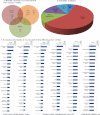Exosomes as biomarker enriched microvesicles: characterization of exosomal proteins derived from a panel of prostate cell lines with distinct AR phenotypes
- PMID: 22723089
- PMCID: PMC3494141
- DOI: 10.1074/mcp.M111.014845
Exosomes as biomarker enriched microvesicles: characterization of exosomal proteins derived from a panel of prostate cell lines with distinct AR phenotypes
Abstract
Prostate cancer is the leading type of cancer diagnosed in men. In 2010, ~217,730 new cases of prostate cancer were reported in the United States. Prompt diagnosis of the disease can substantially improve its clinical outcome. Improving capability for early detection, as well as developing new therapeutic targets in advanced disease are research priorities that will ultimately lead to better patient survival. Eukaryotic cells secrete proteins via distinct regulated mechanisms which are either ER/Golgi dependent or microvesicle mediated. The release of microvesicles has been shown to provide a novel mechanism for intercellular communication. Exosomes are nanometer sized cup-shaped membrane vesicles which are secreted from normal and cancerous cells. They are present in various biological fluids and are rich in characteristic proteins. Exosomes may thus have potential both in facilitating early diagnosis via less invasive procedures or be candidates for novel therapeutic approaches for castration resistance prostate cancer. Because exosomes have been shown previously to have a role in cell-cell communication in the local tumor microenvironment, conferring activation of numerous survival mechanisms, we characterized constitutive lipids, cholesterol and proteins from exosomes derived from six prostate cell lines and tracked their uptake in both cancerous and benign prostate cell lines respectively. Our comprehensive proteomic and lipidomic analysis of prostate derived exosomes could provide insight for future work on both biomarker and therapeutic targets for the treatment of prostate cancer.
Figures









Similar articles
-
Molecular lipidomics of exosomes released by PC-3 prostate cancer cells.Biochim Biophys Acta. 2013 Jul;1831(7):1302-9. doi: 10.1016/j.bbalip.2013.04.011. Biochim Biophys Acta. 2013. PMID: 24046871
-
Exosomes confer pro-survival signals to alter the phenotype of prostate cells in their surrounding environment.Oncotarget. 2016 Mar 22;7(12):14639-58. doi: 10.18632/oncotarget.7052. Oncotarget. 2016. PMID: 26840259 Free PMC article.
-
Comparative Proteomic Analysis of Exosomes and Microvesicles in Human Saliva for Lung Cancer.J Proteome Res. 2018 Mar 2;17(3):1101-1107. doi: 10.1021/acs.jproteome.7b00770. Epub 2018 Feb 13. J Proteome Res. 2018. PMID: 29397740
-
Exosomal microRNAs in liquid biopsies: future biomarkers for prostate cancer.Clin Transl Oncol. 2017 Jun;19(6):651-657. doi: 10.1007/s12094-016-1599-5. Epub 2017 Jan 4. Clin Transl Oncol. 2017. PMID: 28054319 Review.
-
Harnessing tumor-derived exosomes: A promising approach for the expansion of clinical diagnosis, prognosis, and therapeutic outcome of prostate cancer.Biofactors. 2024 Jul-Aug;50(4):674-692. doi: 10.1002/biof.2036. Epub 2024 Jan 11. Biofactors. 2024. PMID: 38205673 Review.
Cited by
-
Optimising Extracellular Vesicle Metabolomic Methodology for Prostate Cancer Biomarker Discovery.Metabolites. 2024 Jun 28;14(7):367. doi: 10.3390/metabo14070367. Metabolites. 2024. PMID: 39057690 Free PMC article.
-
Proteome Profiling of Urinary Exosomes Identifies Alpha 1-Antitrypsin and H2B1K as Diagnostic and Prognostic Biomarkers for Urothelial Carcinoma.Sci Rep. 2016 Sep 30;6:34446. doi: 10.1038/srep34446. Sci Rep. 2016. PMID: 27686150 Free PMC article.
-
The Role of Small Extracellular Vesicles in the Progression of Colorectal Cancer and Its Clinical Applications.Int J Mol Sci. 2022 Jan 26;23(3):1379. doi: 10.3390/ijms23031379. Int J Mol Sci. 2022. PMID: 35163305 Free PMC article. Review.
-
Extracellular vesicles as a promising source of lipid biomarkers for breast cancer detection in blood plasma.J Extracell Vesicles. 2024 Mar;13(3):e12419. doi: 10.1002/jev2.12419. J Extracell Vesicles. 2024. PMID: 38443328 Free PMC article.
-
Microfluidics for exosome isolation and analysis: enabling liquid biopsy for personalized medicine.Lab Chip. 2017 Oct 25;17(21):3558-3577. doi: 10.1039/c7lc00592j. Lab Chip. 2017. PMID: 28832692 Free PMC article. Review.
References
-
- Jemal A., Siegel R., Ward E., Murray T., Xu J., Smigal C., Thun M. J. (2006) Cancer statistics, 2006. CA Cancer J. Clin. 56, 106–130 - PubMed
-
- Chan J. M., Holick C. N., Leitzmann M. F., Rimm E. B., Willett W. C., Stampfer M. J., Giovannucci E. L. (2006) Diet after diagnosis and the risk of prostate cancer progression, recurrence, and death (United States). Cancer Causes Control 17, 199–208 - PubMed
-
- Bruchovsky N., Klotz L. H., Sadar M., Crook J. M., Hoffart D., Godwin L., Warkentin M., Gleave M. E., Goldenberg S. L. (2000) Intermittent androgen suppression for prostate cancer: Canadian Prospective Trial and related observations. Mol Urol 4, 191–199; discussion 201 - PubMed
-
- Gleave M. E., Goldenberg S. L., Chin J. L., Warner J., Saad F., Klotz L. H., Jewett M., Kassabian V., Chetner M., Dupont C., Van Rensselaer S. (2001) Randomized comparative study of 3 versus 8-month neoadjuvant hormonal therapy before radical prostatectomy: biochemical and pathological effects. J Urol. 166, 500–506; discussion 506–507 - PubMed
-
- Lan C. Y., Huang H., Liu J. H. (2008) [Prognostic value of serum CA(125) level change during chemotherapy post-surgery in patients with advanced epithelial ovarian carcinoma]. Zhonghua Fu Chan Ke Za Zhi 43, 732–736 - PubMed
MeSH terms
Substances
LinkOut - more resources
Full Text Sources
Other Literature Sources
Medical
Research Materials

